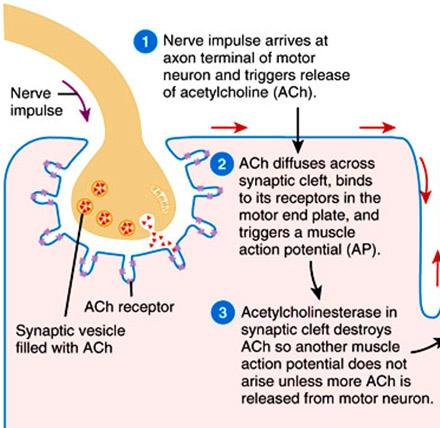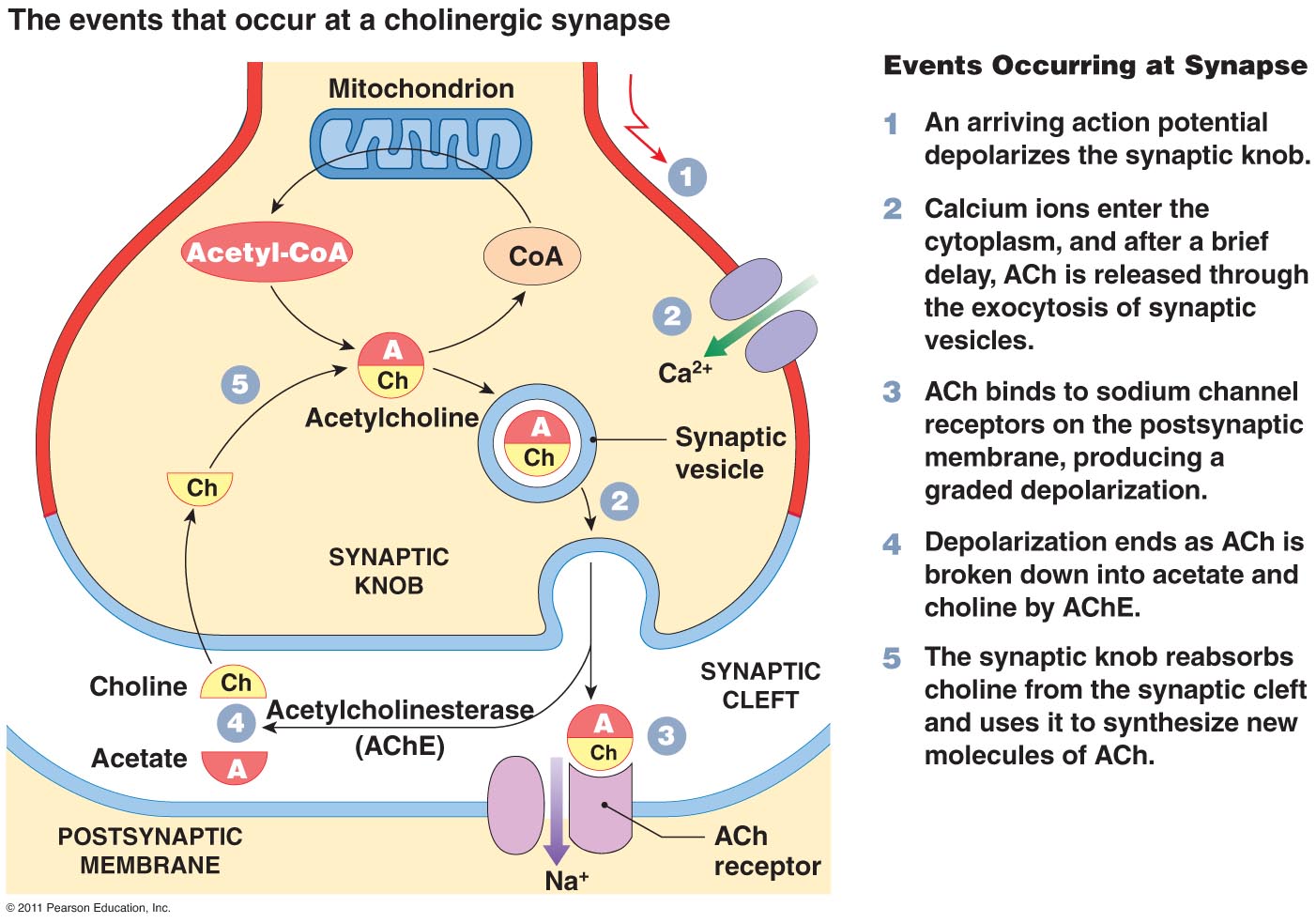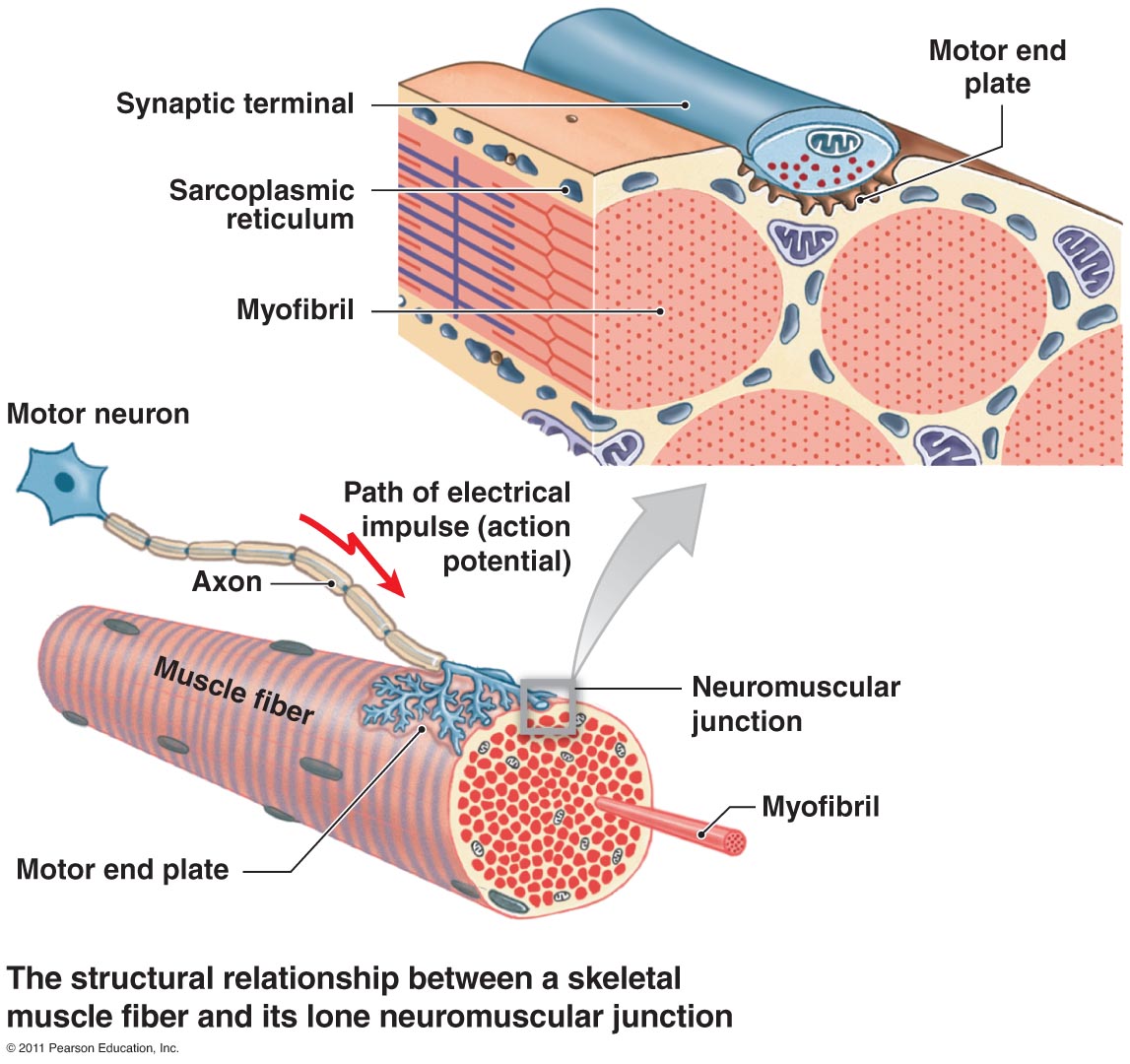Neuromuscular Junction
Dr.A.P.Ganesan
Komarapalayam
1. Decribe the structure of neuro muscular junction(NMU) with help of a diagram and explain the mechanism of transmission of nerve impulse across it.
Definition
It is the junction between the terminal branches of the motor nerves and the skeletal muscle fibers
Structure
Sketele muscle fibers are innervated by the motor nerves. Each nerve fibre divides into many terminal branches. Each terminal branch supplies one muscle fiber.
The junction between the terminal branch of the nerve fiber and muscle fiber is called neuro muscular junction.
Structure of neuro muscular junction.
Each terminal nerve fiber is called axon terminal. While reaching close to the muscle fiber, the axon loses the myelin sheath. So the axon cylinder is eposed. The axon cylinder is expanded like a bulb at its terminal end. This is called motor end plate.
The muscle fiber's membrane below the end plate is thickened. It invaginates into the muscle fiber forming a depression. This depression is known as synaptic trough or gutter.
The motor end plate fits into the trough. The membrane of the nerve ending is called presynaptic membraneThe membrane of the muscle fiber is called post synaptic membrane. The space between these two membranes is called synaptic cleft.
The axon terminal contains mitochondria and synaptic vesicles. These vesicles contain the neuro muscular substances called acetylcholine. The acetyl choline is synthesised in mitochondria and stored in the vesicles
The synaptic cleft contains basal lamina. It is a thin layer of spongy reticular fibers, through which extra cellular fluid diffuses. Large quantity of enzymes called acetyl choline esterases is attached to the matrix of basal lamina.
The post synaptic membrane is thrown into nemerous folds. These folds are called subneural clefts. The post synaptic membrane contains the recepators called nicotinic acetyl choline recptors
Mechanism of Neuromuscular Transmission
Neuro muscular junction transmits impulses from the nerve to the muscle. A series of events occur in neuro muscular junction.
When the impluses are transmitted from the nerve to muscle, a series of events occur in neuro muscular junction. They are
1.release of acetyl choline
2.action of acetyl choline
3.end plate potential
4.miniatre end plate potential
5.destruction of acetyl choline
1. Release of acetyl choline
The nerve fiber transmits the impulses from spinal cord to the muscle in the form of action potential. Hen action potential reaches axon terminal, it increases the permeability of presynaptic membrane for calcium ions, the calcium channel in the membrane are opened. So the calcium ions enter the aon terminal from extra cellular fluid.
The calcium ions cause bursting of vesicles so the neuro transmitter substance called acetyl choline is released from the vesicles. The acetyl choline passes through presynaptic membrane and is released into the synaptic cleft.
2.Action of acetyl choline
The acetyl choline molecules released in to the synaptic cleft bind with nicotinic receptors present in the post synaptic membrane.the acetyl choline - receptors comple opens sodium channel in post synaptic membrane. The sodium ions from extra cellular fluid enter the neuro muscular junction through these channel s. there, the sodium ions cause some changes in the electrical potential. This stste is called end plate potential.
3.End plate potential
The resting potential in neuro muscular junction is -90 mV. When sodium ions enter inside, the end plate potential occurs. There is a depolarisatrion upto -60mV. The end plate potential is non propagative. But it causes development of action potential in the muscle fiber when it reaches to maximum level of -60mV.
4.Miniature end plate potential
Acetyl choline is released in small quantum from nerve terminal. This produces a weak end plate potential. Its amplitude is 0.5mV. This is called miniature potential. This is unable to cause action potential. When more and more quantum of actyl choline are released, they produce action potential in the muscle fibre.
5.Destruction of acetyl choline
Within milliseconds after the release into the synaptic cleft, the acetyl choline is destroyed by the enzymes-acetyl choline esterase. The acetyl choline is more potent and within short period of 1 milisecond it can exicte the muscle fibre.
Agents inhibiting Neuromuscular junction transmission
They are called Neuromuscular blockers. Eg d. tubocurarine, Bungaratoxin, succinyl choline, carbamyl choline, botulinium toxin
Agents stimulating Neuromuscular Junction Transmisson
Some drugs eg neostigmine, physostigmine, di-isopropyl flouro phosphate.
They inactivate acetyl choline esterase and promote the repeated and continuous action of muscle.
Applied Physiology
In Myasthenia gravis the destruction of acetylcholine is delayed → accumulation of acetycholine → delayed repolarization → the next nerve impulse cannot act → muscle fiber is temporarily weak or paralysed
* * * * * * * * * * * * *




